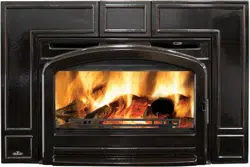Loading ...
Loading ...
Loading ...

W415-1087 / A / 06.06.13
22
EN
!
WARNING
7.0 MAINTENANCE
Check your chimney and chimney connector for creosote and soot buildup weekly until a safe frequency for
cleaning is established.
If accumulation is excessive, disconnect the appliance and clean both the chimney and the appliance. You
may want to call a professional chimney sweep to clean them. Both have to be cleaned at least once a year or
as often as necessary.
Remove the baffl e and clean above it once a year. Replace any broken bricks.
Allow the ashes in your fi rebox to accumulate to a depth of two or three inches (50.8 - 76.2mm); they tend to
burn themselves up. When the fi re has burned down and cooled, remove any excess ashes but leave an ash
bed approximately 1” (25.4mm) deep on the fi rebox bottom to help maintain a hot charcoal bed.
NOTE: Keep ash depth to a minimum to prevent hot embers from overfl owing.
DISPOSAL OF ASHES: Ashes should be placed in a metal container with a tight fi tting lid. The closed
container of ashes should be placed on a non-combustible fl oor or ground, well away from all combustible
materials, pending fi nal disposal. If the ashes are disposed of by burial in soil or otherwise locally dispersed,
they should be retained in the closed container until all cinders have thoroughly cooled.
!
WARNING
TURN OFF THE POWER BEFORE SERVICING THE APPLIANCE.
APPLIANCE MAY BE HOT, DO NOT SERVICE UNTIL APPLIANCE HAS COOLED.
DO NOT USE ABRASIVE CLEANERS.
IMPROPER DISPOSAL OF ASHES RESULT IN FIRES. DO NOT DISCARD ASHES IN CARDBOARD
BOXES, DUMP IN BACK YARDS, OR STORE IN GARAGES.
IF USING A VACUUM TO CLEAN UP ASHES, BE SURE THE ASHES ARE ENTIRELY COOLED. USING
A VACUUM TO CLEAN UP WARM ASHES COULD CAUSE A FIRE INSIDE THE VACUUM.
7.1 ASH REMOVAL PROCEDURES
7.2 CREOSOTE FORMATION AND REMOVAL
84.1A
When wood is burned slowly, it produces tar and other organic vapors, which combine with expelled moisture
to form creosote. The creosote vapors condense in the relatively cooler chimney fl ue of a slow-burning fi re. As
a result, creosote residue accumulates on the fl ue lining. When ignited this creosote makes an extremely hot
fi re.
The chimney connector and chimney should be inspected at least once every two months during the heating
season to determine if a creosote buildup has occurred.
If creosote has accumulated it should be removed to reduce the risk of a chimney fi re.
Loading ...
Loading ...
Loading ...
